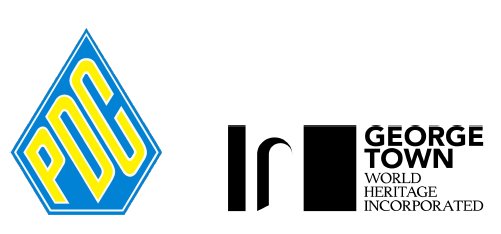
JOINT STATEMENT BY PENANG DEVELOPMENT CORPORATION AND GEORGE TOWN WORLD HERITAGE INCORPORATED ON SIA BOEY REJUVENATION PROJECT
- This is a joint statement issued by Penang Development Corporation (as Project Owner) and George Town World Heritage Incorporated (as Project Partner) on Monday, 29 July 2019 to clarify facts on the Sia Boey Rejuvenation Project.
- The Sia Boey Rejuvenation Project was launched on 25 March 2018 to transform Sia Boey into an area that facilitates the coexistence of development and heritage conservation. On 27 July 2019, we have conducted a Site Visit and shared with the press the latest progress of the restored Prangin Canal, especially on the success of transforming the malodorous, rubbish-filled, and once-abandoned Prangin Canal into a clean and scenic canal.
- Historically, Sia Boey, also known as Ujung Pasir or Prangin, was a natural stream surrounded by mangrove swamps that marked the borders of early 19 th century George Town. The fortification of the Prangin Canal began in 1804. The canal was narrowed circa 1890s in line with the construction of the Sia Boey Market, which demarcated the influence of the British rule on urban George Town life. Drawings sourced from the British Library Archive indicate that the original alignment of the canal began at the shorefront of Weld Quay and had extended all the way inland to the Penang Road/Burmah Road junction. The canal was to serve as a flood mitigation and a
waterway, as well as to drain the swamps of the surrounding areas for agriculture and
residential use.
- The Prangin Canal is approximately 20 ft wide x 5 ft deep. The rubble pitched walls of the canal consist of granite stones and blocks, and the invert is of concrete base overlying the silt strata beneath. The foundation of the canal walls are founded on bakau piles supported by timber shoring, a common construction technique for many pre-war houses in George Town in that era.
- Prior to 2013, the Prangin Canal was primarily used as a large monsoon drain with an upstream catchment area of approximately 278 acres that extends from Burmah Road
(Anson Road) and Muntri Street to Beach Street and Magazine Road, encompassing a vast portion of the UNESCO listed George Town World Heritage Site.
- The Prangin Canal is not classified as a River (Source: Penang Georgraphic Information System, PeGIS). The Prangin Canal does not feed from a natural stream of water (from the Hills of Penang) at the upstream. The Prangin Canal drains to the shorefront just south of Weld Quay where there is a pumping station that discharges the stormwater into the South Channel via the S10 outfall.
- As part of the Enabling Works for the Sia Boey Rejuvenation Project, the Prangin Canal was diverted to a new culvert, aligned parallel to the existing Prangin Canal. The Prangin Diversion was essential, having evaluated the historic significance of the Prangin Canal, whilst taking into consideration the importance of the canal's functionality and the proposal for the Sia Boey Rejuvenation Project. The diversion that was constructed has a higher hydraulic capacity compared to the existing Prangin Canal. The plans for the Prangin Diversion were presented to, and approved by, Majlis Bandaraya Pulau Pinang (MBPP) and the Technical Review Panel (TRP) despite being beyond the boundaries of George Town UNESCO World Heritage Site. The Technical Review Panel committee includes Penang Heritage Trust, which is also a member of the Penang Forum coalition.
- In October 2015, a granite structure was uncovered and later identified as the Old Prangin Canal Basin by Universiti Sains Malaysia's Centre for Global Archaeological Research. The archaeological value of these findings inspired us to transform the site to be the first Urban Archaeological Park in Malaysia.
- Rehabilitation of the old Prangin Canal was conducted from May till August 2018 upon the completion of the Prangin Diversion in October 2016. The old Prangin Canal was thoroughly cleaned and rejuvenated into a water feature that flows within the new
proposed Park. The works involved re-establishing the waterbody within the Prangin
Canal, includes the insertion of a reversible FRP liner and a circulation system to create a water-tight tanked ecosystem within the Prangin Canal.
- A bio-filtration system was installed downstream, which includes bio-balls, bio-brushes, natural shells and an Ultra-Violet Light system. The waterbody is also treated with Effective Microogranism, a proven Japanese bio-remediation technology. The plans for the rejuvenation of the Prangin Canal were presented to, and approved by, the Technical Review Panel (TRP) in February 2018. The authenticity and integrity of the old Prangin Canal were restored, and more than 15,000 artefacts were rescued.
- Incorporating sustainable urbanisation as a core principle, the new Urban Archaeological Park will revitalise the area as a socio-civic centre, with programming and space for the local people. Our focus on the coexistence of heritage conservation, cultural heritage education, a green park and sustainable development will set the benchmark for sustainable urbanisation nationally and globally.
- We strongly reject the accusations by irresponsible individuals who circulated misleading social media posts claiming a hidden agenda was in the project. On the contrary, we have one very open agenda, which is to create a new Urban Archaeological Park for the people, and so that our next generation can learn more about the natural, cultural, and environmental factors that make George Town a UNESCO World Heritage Site.
- We seek assistance from the public to help us by preventing and putting an end to the irresponsible circulation of false information that aim to deliberately obstruct the completion of this project.
Dato Mohd Bazid Abd Kahar, General Manager, Penang Development Corporation and Dr Ang Ming Chee, General Manager, George Town World Heritage Incorporated.
Copyright © 2018-2021 AnakPinang. All Rights Reserved.

